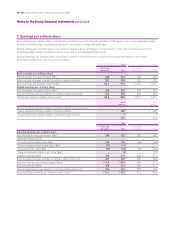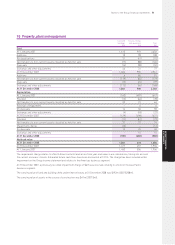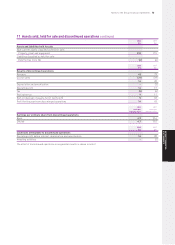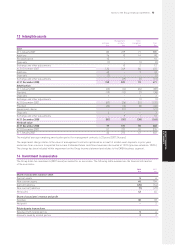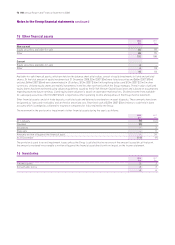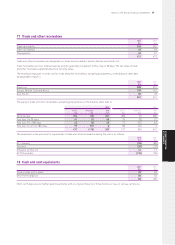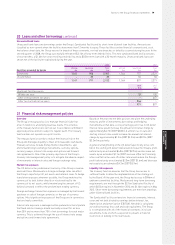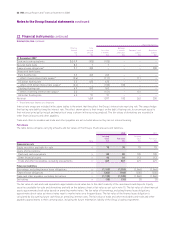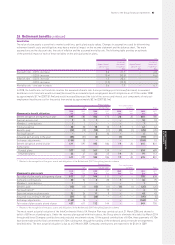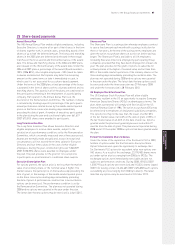Holiday Inn 2008 Annual Report Download - page 82
Download and view the complete annual report
Please find page 82 of the 2008 Holiday Inn annual report below. You can navigate through the pages in the report by either clicking on the pages listed below, or by using the keyword search tool below to find specific information within the annual report.
80 IHG Annual Report and Financial Statements 2008
21 Financial risk management policies continued
Notes to the Group financial statements continued
At the year end, the Group had surplus cash of $82m which is
held in short-term deposits and cash funds which allow daily
withdrawals of cash. Most of the Group’s surplus funds are held
in the UK or US and there are no material funds where repatriation
is restricted as a result of foreign exchange regulations.
Credit risk exposure
Credit risk on treasury transactions is minimised by operating a
policy on the investment of surplus cash that generally restricts
counterparties to those with an A credit rating or better or those
providing adequate security.
Notwithstanding that counterparties must have an A credit rating
or better, during periods of significant financial market turmoil,
counterparty exposure limits are significantly reduced and
counterparty credit exposure reviews are broadened to include
the relative placing of credit default swap pricings.
The Group trades only with recognised, creditworthy third parties.
It is the Group’s policy that all customers who wish to trade on
credit terms are subject to credit verification procedures.
In respect of credit risk arising from financial assets, the Group’s
exposure to credit risk arises from default of the counterparty,
with a maximum exposure equal to the carrying amount of
these instruments.
Capital risk management
The Group manages its capital to ensure that it will be able to
continue as a going concern. The capital structure consists of net
debt, issued share capital and reserves. The structure is managed
to minimise the Group’s cost of capital, to provide ongoing returns
to shareholders and to service debt obligations, whilst maintaining
maximum operational flexibility. Surplus cash is either reinvested
in the business, used to repay debt or returned to shareholders.
The Group maintains a conservative level of debt. The level of debt
is monitored on the basis of a cash flow leverage ratio, which is net
debt divided by EBITDA.
Hedging
Interest rate risk
The Group hedges its interest rate risk by taking out interest rate
swaps to fix the interest flows on between 25% and 75% of its net
borrowings in major currencies. At 31 December 2008, the Group
held interest rate swaps (swapping floating for fixed) with notional
principals of USD250m, GBP75m and EUR75m (2007 USD100m,
GBP150m and EUR75m). The Group also held forward-starting
interest rate swaps with notional principals of USD100m, GBP75m
and EUR75m (2007 GBP150m and EUR75m). These swaps will
replace current swaps with the same notional principals when they
mature in 2009. The interest rate swaps are designated as cash
flow hedges of borrowings under the Syndicated Facility and they
are held on the balance sheet at fair value in other financial assets
and other payables.
Changes in the fair value of cash flow hedges are recognised in the
unrealised gains and losses reserve to the extent that the hedges
are effective. When the hedged item is recognised, the cumulative
gains and losses on the hedging instrument are recycled to the
income statement. No ineffectiveness was recognised during the
current or prior year.
Foreign currency risk
The Group is exposed to foreign currency risk on income streams
denominated in foreign currencies. When appropriate, the Group
hedges a portion of forecast foreign currency income by taking
out forward exchange contracts. The designated risk is the spot
foreign exchange risk. Forward contracts are held at fair value on
the balance sheet as other financial assets and other payables.
Hedge of net investment in foreign operations
The Group designates its foreign currency bank borrowings and
currency derivatives as net investment hedges of foreign operations.
The designated risk is the spot foreign exchange risk; the interest
on these financial instruments is taken through financial income
or expense and the derivatives are held on the balance sheet at
fair value in other financial assets and other payables.
Hedge effectiveness is measured at calendar quarter ends.
Variations in fair value due to changes in the underlying exchange
rates are taken to the currency translation reserve until an operation
is sold, at which point the cumulative currency gains and losses
are recycled against the gain or loss on sale. No ineffectiveness
was recognised on net investment hedges during the current or
prior year.
At 31 December 2008, the Group held foreign exchange derivatives
with a principal of $nil (2007 $12m) and a fair value of $nil
(2007 $nil). The maximum amount of foreign exchange derivatives
held during the year as net investment hedges and measured at
calendar quarter ends had a principal of $70m (2007 $533m) and
a fair value of $(4.2)m (2007 $3.1m).


